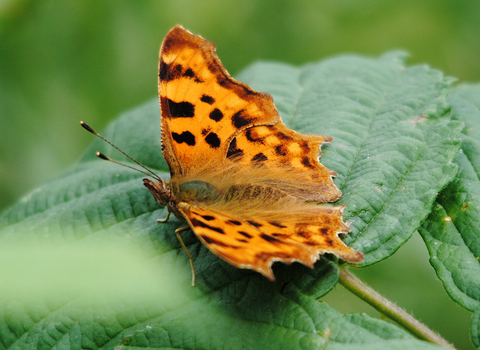Parc Slip Nature Reserve is home to some of Wales’ rarest and most precious wildlife, from the endangered great crested newt that breeds in the ponds and lakes, to the elusive harvest mouse and charismatic lapwing found in the wildflower meadows, which are themselves alive with orchids, ragged robin and buttercups.
Wild About Parc Slip (https://youtu.be/O7mzFfvFmiw)
Video: Liv Davies
Species Highlights
Great Crested Newt
The European protected great crested newt is Britain’s largest newt species. They are prehistoric in appearance, with black warty skin and bright orange bellies. In the breeding season, males sport a fantastic wavy crest along their back. We are lucky enough to have a healthy breeding population of great crested newt at Parc Slip.
Lapwing
The beautiful lapwing can be seen in spring around the Northern Wetlands on the reserve, and if you are lucky you may see the males during an aerial display, when they tumble through the air on their distinctive broad wings accompanied by the almost mechanical sounding ‘peewit’ call.
We currently manage the field adjacent to the Northern Wetlands for lapwing by keeping the grass cut short for breeding and clearing the adjacent scrub in the winter to reduce the number of perches for aerial predators!
Bee Orchids
Bee Orchids (Ophrys apifera) can be found flowering around the nature reserve and can be recognised by the unusual flower shape. Bee orchid’s evolved bee-like flowers to attract their main pollinators; bees! Although the orchid’s specific bee pollinator doesn’t occur in the UK, the bee orchid self-pollinates and can be seen between June and July.
Scarce blue-tailed Damselfly
Conservation work takes place on the reserve in the winter for the scarce blue-tailed damselfly (Ischnura pumilio) which is one of our smallest damselflies. The species is usually found in shallow wetland sites with open vegetation so we maintain shallow pools throughout the reserve and complete scrub clearance around these shallow pools, ready for the damselfly to breed in the summer.
Grass Snake
There is also a very good population of the largest British snake, the grass snake, living on the reserve. This snake is greenish brown in colour with a band of yellow around the neck. This species can be seen basking around the reserve, but once it has seen you it’s usually gone in the blink of an eye! For a chance to see these amazing snakes, come and join us on Wednesday mornings for a Reptile Ramble on the reserve (details on the events page).
There is of course a multitude of other fantastic species out on the reserve, and we are always interested to know what people have seen.
Wild Parc Slip Virtual Reality Experience!
Get up and close to some of Parc Slip's amazing wildlife with our new 360 experience!
Wild Parc Slip Virtual Reality Experience (https://www.youtube.com/watch?v=QC2s6zfPeWA&t=7s)
Get ready to soar with our 360 degree virtual reality experience!

